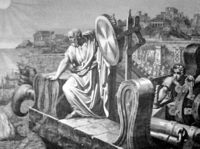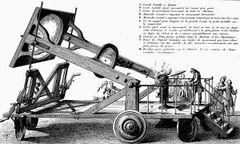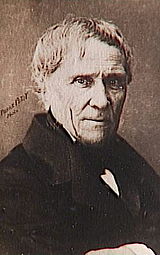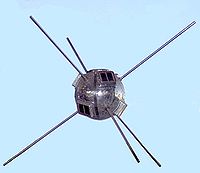Difference between revisions of "History of solar energy"
Solarpedia (Talk | contribs) |
Solarpedia (Talk | contribs) |
||
| Line 4: | Line 4: | ||
It is the same sun worship in many ancient civilizations, such as the Indian civilizations, Persian and Greek. | It is the same sun worship in many ancient civilizations, such as the Indian civilizations, Persian and Greek. | ||
| − | [[File: | + | [[File:Archimedes_burning_mirrors.jpg|200px|thumb|right|Archimedes and one of his burning mirrors]] |
'''The Greek''' would be the first civilization to use the sun as an active solar energy. Indeed, during the opening ceremony of the first Olympic Games of 776 BC., the Olympic flame was lit by the sun with the skaphia, the ancestor of the [[parabolic mirror]]<ref>The Olympic Museum, 2nd edition 2007 - The Olympic flame and torch relay :[http://www.olympic.org/Documents/Reports/EN/en_report_655.pdf]</ref>. | '''The Greek''' would be the first civilization to use the sun as an active solar energy. Indeed, during the opening ceremony of the first Olympic Games of 776 BC., the Olympic flame was lit by the sun with the skaphia, the ancestor of the [[parabolic mirror]]<ref>The Olympic Museum, 2nd edition 2007 - The Olympic flame and torch relay :[http://www.olympic.org/Documents/Reports/EN/en_report_655.pdf]</ref>. | ||
| Line 22: | Line 22: | ||
In the 18<sup>th</sup> century, the burning mirror of antiquity and of the Inca Empire resurfaced in France. '''Georges-Louis Leclerc, Comte de Buffon''' built in 1747 a mirror composed of 168 flat glasses of six inches wide and eight high. So he melts different metals such as tin, lead and silver<ref>E. Kreyszig, ''Archimedes and the invention of burning mirrors : an investigation of work by Buffon, in Geometry, analysis and mechanics'', River Edge, NJ, 1994, p. 139-148</ref>. | In the 18<sup>th</sup> century, the burning mirror of antiquity and of the Inca Empire resurfaced in France. '''Georges-Louis Leclerc, Comte de Buffon''' built in 1747 a mirror composed of 168 flat glasses of six inches wide and eight high. So he melts different metals such as tin, lead and silver<ref>E. Kreyszig, ''Archimedes and the invention of burning mirrors : an investigation of work by Buffon, in Geometry, analysis and mechanics'', River Edge, NJ, 1994, p. 139-148</ref>. | ||
| − | [[File: | + | [[File:Lavoisier_solar_cooker.jpg|240px|thumb|left|The solar cooker of Antoine Laurent de Lavoisier]] |
Experiences around solar accelerate. In 1774,'''Antoine Laurent Lavoisier''', chemist, philosopher and economist, invents a [[solar cooker]] composed of converging lenses in order to melt metals. | Experiences around solar accelerate. In 1774,'''Antoine Laurent Lavoisier''', chemist, philosopher and economist, invents a [[solar cooker]] composed of converging lenses in order to melt metals. | ||
Latest revision as of 14:45, 28 February 2017
Contents
The Sun, a source of divine energy (until the XVIth century)
Egyptian would be the first civilization to make a great worship to the sun. From the pre-dynastic period (until -XXXIth century), the sun god is called Atum primitive deity of the city of Heliopolis. Then it will lose its power during the period of the Old Empire (-2700 to -2200 BC.) In favor of Ra. It is the same sun worship in many ancient civilizations, such as the Indian civilizations, Persian and Greek.
The Greek would be the first civilization to use the sun as an active solar energy. Indeed, during the opening ceremony of the first Olympic Games of 776 BC., the Olympic flame was lit by the sun with the skaphia, the ancestor of the parabolic mirror[1].
The invention of the burning mirror is reused five centuries later by Archimedes during the siege of Syracuse (Sicily). While the Greek colony was attacked by the Roman fleet, legend says that Archimedes had developed giant polished bronze mirrors to reflect and concentrate the sun's rays to burn the sails of Roman ships.
On the other side of the Atlantic Ocean, Inti the sun god of Incas sends Manco Capac, the legendary first emperor of the Incas. So, the worship of the sun became very important. From the fifteenth century, it became one of the most popular rituals: the Inti Raymi (the resurrection of the sun). It takes place in the Inca capital Cuzco during the winter solstice, June 24, and for 9 days during which the Incas were suitable for dancing but also sacrifices. On this occasion, a fire was lit by the High Priest with a gold bracelet: the chipana[2].
The era of solar inventions (XVIth to XVIIIth centuries)
In Europe, we must wait the 16th century and the coming of Leonardo da Vinci to give an impetus to solar technologies. In 1515, Leonardo da Vinci invented a new solar concentrator: a sytem of CLFR type (Compact Linear Fresnel Reflector). However, this system seems to have existed only on paper.
In 1615, Solomon Gaus built a solar pump. The driving force was provided by the air heated from solar radiation.
In the 18th century, the burning mirror of antiquity and of the Inca Empire resurfaced in France. Georges-Louis Leclerc, Comte de Buffon built in 1747 a mirror composed of 168 flat glasses of six inches wide and eight high. So he melts different metals such as tin, lead and silver[3].
Experiences around solar accelerate. In 1774,Antoine Laurent Lavoisier, chemist, philosopher and economist, invents a solar cooker composed of converging lenses in order to melt metals.
Still in the 18th century, Horace-Benedict de Saussure' develops in 1774 a measurement instrument enabling him to study the heating effects of the sun, the helio thermometer. It looks like "hot" boxes with insulated walls and one or more windows. Horace-Benedict obtained with this device a temperature of 88°C. This invention is both the ancestor of Solar oven and Flat plate collector[4].
In 1816, the Scottish pastor Robert Stirling deposited a patent about an "external combustion engine", also called "hot air engine." Now called "Stirling Engine".
The magic of electricity (IXth century)
The XIXth century is the century of the electric revolution. Alessandro Volta created the electric battery (1800)[5], in 1827 the Hungarian Ányos Jedlik made the first dynamo[6]. In 1879, Thomas Edison presented his first electric incandescent lamp[7] and built the first urban grid in direct current (1882)[8]. Seeing here a growing market, the industrial George Westinghouse with the help of the engineer Nikola Tesla, develops another grid in 1886, but this time in alternating current[9].
The electric revolution is also done by the discovery of photovoltaics. In 1839, Antoine César Becquerel (the grandfather Henri Becquerel), discovered the photovoltaic principle. The German physicist Heinrich Rudolf Hertz understood it and introduced the photovoltaic effect as such in 1887. But it was Albert Einstein who first, was able to explain the photovoltaic principle, and with the the added benefit, the Nobel Prize for Physics in 1921[10].
Thermal energy also continues to grow. In 1874, the first solar distiller was born in Salinas, on top of Atacama plateau in Chile, which produces 23 tons of fresh water per sunny day. Some decades later, the English physicist Charles Vernon Boys invented and implemented the first parabolic trough system in 1912. He has created the first solar power plant in Meadi, Egypt, used to pump irrigation water.
Despite the many advantages of this clean energy, the 20th century gives way to thermal energy from oil. Oil is plentiful, very cheap, it is considered as a strategic raw material, at the origin of the geopolitics of oil. Thus, solar is no more attractive, projects and discoveries become rare.
The democratization of solar energy (XXth-XXIst centuries)
We have to wait the end of World War II to find new developments in the field of solar thermal. The French Félix Trombe has the idea of using a DCA projector abandoned by the Germans in Mont-Louis (Pyrénées-Orientales, France). In 1949, he transformed it into Solar oven with a power of 50kW.
Photovoltaic technology grows in small steps. In 1954, U.S. researchers (Chapin, Fuller, Pearson and Prince) working for Bell Telephone Laboratories developed a photovoltaic cell with high yield of 6% in order to power the phones in remote areas. However the technology is still too expensive for widespread use[11].
Despite its cost, space research stimulate research in the field of photovoltaics. A cell with a yield of 9% is developed four years later and the first satellite with solar cells, Vanguard 1 is sent into space the 17th of March 1958[12].
In 1963, Italian Giovanni Francia and the French Marcel Perrot install the first CLFR system (Compact Linear Fresnel Reflector) in Marseille, around 450ans after its invention by Leonardo da Vinci.
Meanwhile, the furnace of Mont-Louis knows a good level of performance. Thus the French government built a solar oven almost industrial in Odeillo. Commissioned in 1970, the solar oven of Odeillo has a capacity of 1MW.
We have to wait 1973 and the first oil shock that governments decide to change their energy sources. The research in alternative energies is accentuated. In the same year, the first house with a photovoltaic system is found at the University of Delaware in the United States.
In 1983, EDF and CNRS build Themis, the first French electrosolar central tower with a power of 2500 kW. However, the political of all nuclear will surpass it, and it closed three years later.
The same year, the Australian Hans Tholstrup travels 4000 km on "Quiet Achiever", the first solar car. He founded in 1987 the "World Solar Challenge", the first solar car race.
Today, as a result of environmental awareness and rising fossil energy, policies for renewable energy have increased over the 5 continents.
Notes and References
- ↑ The Olympic Museum, 2nd edition 2007 - The Olympic flame and torch relay :[1]
- ↑ F.S. Crofts & Co., New York 1937, An introduction to primitive culture : [2]
- ↑ E. Kreyszig, Archimedes and the invention of burning mirrors : an investigation of work by Buffon, in Geometry, analysis and mechanics, River Edge, NJ, 1994, p. 139-148
- ↑ Solar Cookers International Network, Horace de Saussure and his Hot Boxes of the 1700's: [3]
- ↑ A provincial electrician in eighteenth-century England - Abraham Bennet F.R.S:[4]
- ↑ Made in Hungary: Hungarian contributions to universal culture - Andrew L. Simon:[5]
- ↑ Electric light - Thomas A. Edison:[6]
- ↑ newspaperarchive.com - The New-York Times, Tuesday, September 5, 1882:[7]
- ↑ The Day They Turned The Falls On: The Invention Of The Universal Electrical Power System:[8]
- ↑ The Nobel Prize in Physics 1921:[9]
- ↑ April 25, 1954: Bell Labs Demonstrates the First Practical Silicon Solar Cell:[10]
- ↑ U.S. Department of Energy - Solar History Timeline: 1900s:[11]



